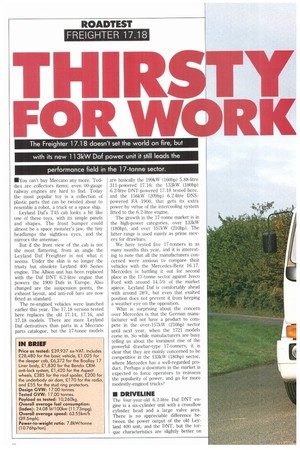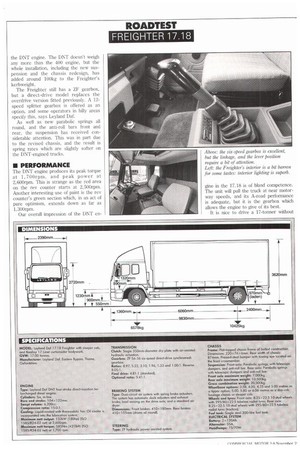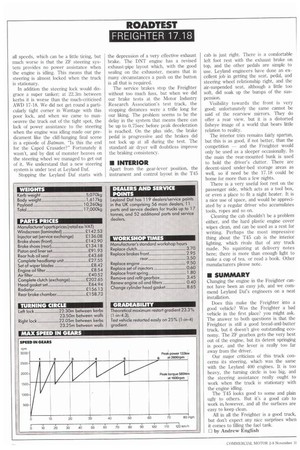The Freighter 17.18 doesn't set the world on fire, but
Page 56

Page 58

Page 59

Page 60

If you've noticed an error in this article please click here to report it so we can fix it.
with its new 11 3kW Daf power unit it still leads the performance field in the 17-tonne sector.
NYou can't buy Meccano any more. Teddies are collectors items; even 00-gauge railway engines are hard to find. Today the most popular toy is a collection of plastic parts that can be twisted about to resemble a robot, a truck or a space ship.
Leyland Dafs T45 cab looks a bit like one of these toys, with its simple panels and shapes. The front bumper could almost be a space monster's jaw, the tiny headlamps the sightless eyes, and the mirrors the antennae.
But if the front view of the cab is not the most flattering, from an angle the Leyland Daf Freighter is not what it seems. Under the skin is no longer the trusty but obsolete Leyland 400 Series engine. The Albion unit has been replaced with the Daf DNT 6.2-litre engine that powers the 1900 Dafs in Europe. Also changed are the suspension points, the exhaust layout, and anti-roll bars are now fitted as standard.
The re-engined vehicles were launched earlier this year. The 17.18 version tested here replaces the old 17.14, 17.16, and 17.18 models. There are more Leyland Daf derivatives than parts in a Meccano parts catalogue, but the 17-tonne models are basically the 199kW (160hp) 5.88-litre 311-powered 17.16; the 133kW (180hp) 6.2-litre DNT-powered 17.18 tested here, and the 156kW (209hp) 6.2-litre DNSpowered FA 1900, that gets its extra power by virtue of the intercooling system fitted to the 6.2-litre engine.
The growth in the 17-tonne market is in the high-power categories, over 133kW (180hp), and over 157kW (210hp). The latter range is used mainly as prime movers for drawbars.
We have tested five 17-tonners in as many months this year, and it is interest ing to note that all the manufacturers con cerned were anxious to compare their vehicles with the Mercedes-Benz 16.17.
Mercedes is battling it out for second place in the 17-tonne sector against Iveco Ford with around 14.5% of the market apiece. Leyland Dot is comfortably ahead with around 28%, but even that exalted position does not prevent it from keeping a weather eye on the opposition.
What is surprising about the concern over Mercedes is that the German manu facturer will not have a product to com pete in the over-157kW (210hp) sector until next year, when the 1721 models come in. So while manufacturers are busy telling us about the imminent rise of the powerful drawbar-type 17-tonners, it is clear that they are mainly concerned to be competitive in the 133kW (180hp) sector, where Mercedes has a well-regarded pro duct. Perhaps a downturn in the market is expected to force operators to reassess the popularity of power, and go for more modestly-engined trucks?
• DRIVELINE
The four-year-old 6.2-litre Daf DNT engine is a six-cylinder unit with a crossflow cylinder head and a large valve area. There is no appreciable difference between the power output of the old Leyland 400 unit, and the DNT, but the torque characteristics are slightly better on
the DNT engine. The DNT doesn't weigh any more than the 400 engine, but the whole installation, including the new suspension and the chassis redesign, has added around 100kg to the Freighter's kerbweight.
The Freighter still has a ZF gearbox, but a direct-drive model replaces the overdrive version fitted previously. A 12speed splitter gearbox is offered as an option, and some operators in hilly areas specify this, says Leyland Daf.
As well as new parabolic springs all round, and the anti-roll bars front and rear, the suspension has received considerable attention. This was in part due to the revised chassis, and the result is spring rates which are slightly softer on the DNT-engined trucks.
II PERFORMANCE
The DNT engine produces its peak torque at 1,700rpm, and peak power at 2,600rpm. This is strange as the red area on the rev counter starts at 2,500rpm. Another interesting use of paint is the rev counter's green section which, in an act of pure optimism, extends down as far as 1,30Orpm.
Our overall impression of the DNT en Above: the six-speed gearbox is excellent, but the linkage, and the lever position require a bit of attention.
Left: the Freighter's interior is a bit barren for some tastes: interior lighting is superb.
gine in the 17.18 is of bland competence. The unit will pull the truck at near motorway speeds, and its A-road performance is adequate, but it is the gearbox which allows the engine to give of its best.
It is nice to drive a 17-tonner without the ubiquitous Eaton 4106 six-speed box, which is fitted to the Iveco Ford, Steyr and AWL). Unlike the ZF box fitted to the Volvo FL6, this unit was more 'userfriendly'.
The ratios are ideal for the engine: sixth gear is especially good, allowing the truck to climb small hills without a tiresome downchange. Second gear is also well selected for accelerating away from a hazard like a 1-junction before an upchange to third is needed. It can be used to creep along in traffic too many of the 17.18's competitors suffer from too low or high a second gear, which is unable to do both of these functions.
In addition to the good gear spacing, we also found the syncromesh to be unbeatable, with light and positive lever movements. On the minus side, however, the linkage to the gearlever on the Freighter installation is not the best we have come across. The detent springs that hold the gear level in the third/fourth plane are too weak for the job, which makes finding the right gear a slow process.
Our other criticism is that the lever is slightly too long which, combined with the long throw of the lever, makes the furthest gears a bit of a stretch out of the seat for the driver. We understand that Leyland Daf might revise the layout of the interior andlor linkage to improve matters.
With a fuel consumption of 24.081it/ 100km (11.73mpg), the Leyland Daf does not make the hall of fame for economy. Its overall speed, however, is significantly higher than the competition we have tested. Only the Volvo FL617 has a worse fuel consumption than the Leyland Daf, and of the comparison vehicles the Mercedes-Benz 1617 has the best fuel consumption of all at 22.61it/100km (12.54mpg). Perhaps that's why it seems to be the truck to beat.
We should mention that the Iveco Ford Cargo 1718 returned a consumption of 21.71iti100km (13.01mpg) around Wales, but this vehicle was fitted with special aerodynamic bodywork
• HANDLING
There is no doubt that the softer parabolic springs and anti-roll bars fitted to the 17.18 allow a better ride than the older models. It is still not as good some of the competition, however.
The motorway ride is perfectly acceptable, but on poor A-roads the truck jolts up and down a bit too much for comfort. Some of the bigger bumps are kept from the driver by the standard air-suspended seat but long waves in the road give the driver a floating sensation if the seat is set up to deal with the sharper jolts.
If the Freighter's ride is just acceptable, then the steering certainly isn't. We now have every respect for the drivers who have to manhandle these trucks into crowded pedestrian precints for deliveries. The steering weight is quite heavy at all speeds, which can be a little tiring, but much worse is that the Z.F steering system provides no power assistance when the engine is idling. This means that the steering is almost locked when the truck is stationary.
In addition the steering lock would disgrace a super tanker; at 22.3m between kerbs it is worse than the much-criticised AWD 17-18. We did not get round a particularly tight corner in Wantage with this poor lock, and when we came to manoeuvre the truck out of the tight spot, the lack of power assistance to the steering when the engine was idling made our predicament like the cliff-hanging final scene in a episode of Batman. "Is this the end for the Caped Crusader?" Fortunately it wasn't, and by dint of monster heaves on the steering wheel we managed to get out of it. We understand that a new steering system is under test at Leyland Daf.
Stopping the Leyland Daf starts with the depression of a very effective exhaust brake. The DNT engine has a revised exhaust-pipe layout which, with the good sealing on the exhauster, means that in many circumstances a push on the button is all that is required.
The service brakes stop the Freighter without too much fuss, but when we did our brake tests at the Motor Industry Research Association's test track, the stopping distances were a trifle long for our liking. The problem seems to be the delay in the system that means there can be up to 0.75sec before peak deceleration is reached. On the plus side, the brake pedal is progressive and the brakes did not lock up at all during the test. The standard air dryer will doubtless improve the braking consistency.
• INTERIOR
Apart from the gear-lever position, the instrument and control layout in the 145 cab is just right. There is a comfortable left foot rest with the exhaust brake on top, and the other pedals are simple to use. Leyland engineers have done an excellent job in getting the seat, pedal, and steering wheel relationship right, and the air-suspended seat, although a little too soft, did soak up the bumps of the suspension.
Visibility towards the front is very good; unfortunately the same cannot be said of the rearview mirrors. They do offer a rear view, but it is a distorted fisheye image of a world that bears little relation to reality.
The interior trim remains fairly spartan, but this is as good, if not better, than the competition — and the Freighter would only be used as a sleeper occasionally. In the main the rear-mounted bunk is used to hold the driver's clutter. There are decent-sized under-bed storage areas as well, so if need be the 17.18 could be home for more than a few nights.
There is a very useful foot rest on the passenger side, which acts as a tool box, or even a place to fit a night heater. It is a nice use of space, and would be appreciated by a regular driver who accumulates tools, ropes and so on.
Cleaning the cab shouldn't be a problem either, and the hard plastic engine cover wipes clean, and can be used as a rest for writing. Perhaps the most impressive thing about the 145 cab is the interior lighting, which rivals that of any truck made. No squinting at delivery notes here; there is more than enough light to make a cup of tea, or read a book. Other manufacturers please note.
• SUMMARY
Changing the engine in the Freighter cannot have been an easy job, and we commend Leyland Daf's engineers on a neat installation.
Does this make the Freighter into a good vehicle? Was the Freighter a bad vehicle in the first place? you might ask. The answer to both questions is. that the Freighter is still a good bread-anti-butter truck, but it doesn't give outstanding economy. The ZF gearbox gets the very best out of the engine, but its detent springing is poor, and the lever is really too far away from the driver.
Our major criticism of this truck concerns its steering, which was the same with the Leyland 400 engines. It is too heavy, the turning circle is too big, and the steering assistance really ought to work when the truck is stationary with the engine idling.
The T45 looks good to some and plain ugly to others. But it's a good cab to work in, however, and all the surfaces are easy to keep clean.
All in all the Freighter is a good truck, but don't expect any nice surprises when it comes to filling the fuel tank.
CI by Andrew English


























































































































































